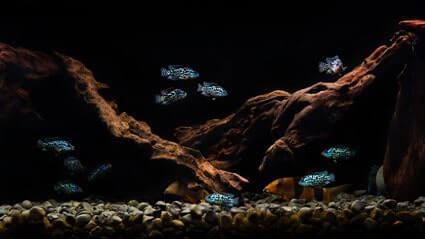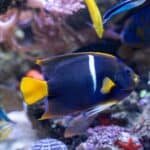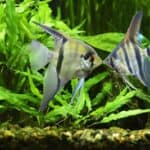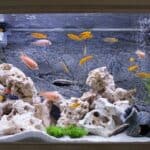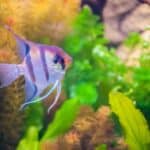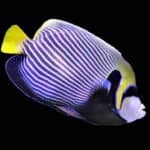Cichlids are an aggressive species. Despite their reputation, some cichlids make good community fish and can live alongside other species if they’re not overly aggressive or small.
Angelfish and dwarf cichlids are the least aggressive cichlids. Other gentle varieties include the blue acara, Bolivian ram, discus fish, German blue ram, severums, keyhole, and rainbow cichlids.
These fish are native to South America, which produces the friendliest cichlids. Most African cichlids are aggressive, but the electric yellow lab and the masked Julie are more peaceful.
Why Are Cichlids Aggressive?
Cichlids, especially African cichlids, have a reputation for being an aggressive fish species. That’s because they’re rock-dwelling fish, so they’re territorial.
Rock-dwelling fish like claiming their section of the tank and pick fights with fish that try to claim this territory as theirs. Cichlids also fight for food, especially if it’s scarce. Instead of missing out, cichlids become aggressive and chase other fish away.
Other things that make cichlids aggressive include:
- Mating behavior.
- Tank dominance.
- An unclean environment.
- Overcrowding.
Nature explains how fish become aggressive to secure food, territory, and reproductive resources.
You can mix cichlids of similar sizes within the same tank, but if you do, keep no more than one cichlid of every species to prevent them from ganging up on other fish. However, peaceful cichlids are much more tolerant of different fish species.
Which Cichlids Are The Least Aggressive?
There are estimated to be between 2,000 to 3,000 species of cichlid across the world, although only around 1,650 are known. They’re popular freshwater fish, usually found in tropical America, mainland Africa, and Madagascar. Some also live in southern Asia.
Because of the vast diversity within the cichlid family, it’s hard to choose the best ones for your community tank. But some species are far less aggressive than others, making them better suited to living with other fish.
If you’re looking to build your aquarium, consider some of the following friendly cichlids:
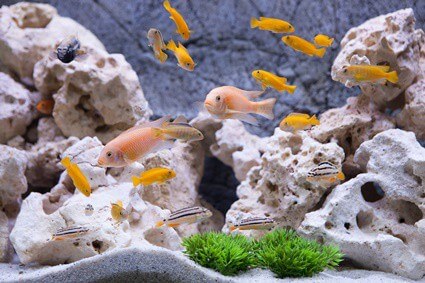
Agassiz’s Dwarf Cichlid
The Agassiz’s dwarf cichlid is a peaceful community fish that’s happy to live with other non-aggressive fish. Agassiz’s dwarf cichlids are a South American species, so they are naturally more friendly than their African cousins.
However, they do prefer to claim a piece of territory, so add plenty of rocks and caves into the tank. Similarly, males can be slightly more aggressive towards other males, but if there are enough females and plenty of space within the tank, most of this aggression can be avoided.
House one male for every four females and keep them in an aquarium with fish of roughly the same size. Also, aim to choose community fish that aren’t likely to nip at their long tails and fins.
Angelfish
Angelfish are well known as one of the least aggressive South American cichlids and are the most peaceful of them all. They can be aggressive towards each other during the mating seasons, but they’re well-behaved around other fish species.
Although all angelfish species inherit the same peaceful personality, you can’t go far wrong with whichever sub-species you choose. Be sure to keep their tank clean to minimize stress levels, which can make angelfish aggressive.
However, they’re opportunistic feeders and will attempt to eat anything they can fit in their mouth. For that reason, they must be housed with fish that are larger than two inches.
The least aggressive angelfish include:
- Veil.
- Zebra.
- Ghost.
- Koi.
- Altum.
Although all species of angelfish inherit the same peaceful personality, you can’t go far wrong with whichever sub-species you choose.
Keep their tank clean to reduce stress levels, which can make angelfish aggressive.
Blue Acara
Blue acaras are a beautiful cichlid species with bright blue scales that look fantastic underwater. They’re bigger than many other cichlids, reaching seven inches long. That means they need a relatively large tank of at least 50 gallons.
However, with suitable tank space and conditions, they’re friendly fish that thrive in community tanks. The species is native to the lakes of Central and South America, which explains their calmer temperament.
During spawning, blue acara fish exhibit slightly more territorial behaviors as they protect their eggs, but this is common and will diminish once the breeding season is over. As well as hiding amongst the plants, the blue acara likes to dig into its substrate, sometimes uprooting plants.
When it comes to cichlids, blue acaras are some of the most gentle and friendly, so beginners do well with them.
Bolivian Ram
Bolivian rams only reach three inches long, making them one of the smaller cichlids. This also makes them a dwarf cichlid.
Because they’re so peaceful, they’re compatible with most other community fish. They’re also easy-going and prefer to stay out of harm’s way by keeping themselves to themselves and hiding between the plants in the tank.
Some Bolivian rams are shy, so they enjoy the company of other quiet fish with similar temperaments.
As with most other cichlids, the only time they display aggression is during breeding season when other fish get too close. They’ll scare them off by chasing them, but they’re unlikely to nip them.
Despite their name, Bolivia rams are native to the Amazon River Basin. Again, South American cichlids are much less aggressive than African cichlids, which explains their docile personality.
Discus Fish
Alongside angelfish, discus fish are another popular aquarium fish. The species is commonly known as the king of freshwater fish. Reaching lengths of eight inches, discus fish are among the large, non-aggressive cichlids.
Despite their cichlid genes, discus fish are gentle and peaceful. They’re also shy and easily frightened, meaning they don’t do well with aggressive or dominant fish. As a result, many hobbyists don’t even mix their discus fish with too many other species. Suitable discus tank mates include:
- Tetras.
- Neons.
- Clown loaches.
- Rummynose tetras.
They all share similar water requirements, so they can comfortably live in the same aquarium. Discus fish also have adequate tank compatibility with angelfish.
Similarly, dither fish are an excellent way to show discus fish that they’re not dangerous. When they school around the tank, discus fish will feel comfortable enough to swim about freely themselves.
Electric Yellow Lab
Also known as the lemon cichlid because of its bright yellow scales, the electric yellow lab fish is commonly considered the least aggressive African cichlid. They’re also the most popular African sub-species in the aquarium fish trade.
They only reach around four inches, making them one of the smaller cichlids. They also boast a relatively peaceful demeanor. While electric yellow labs aren’t quite as friendly as their South American cousins, they’re far gentler than most other cichlids, including many South American species.
Again, like other cichlids, males become aggressive towards other males if the tank’s not stocked with enough females. They also don’t like males of different species, so the tank must be large enough for them to get away from one another.
German Blue Ram
Also known as the butterfly or Ramirez’s dwarf cichlid, the German blue ram is another dwarf cichlid species. They’re mellow and easy-going, preferring to do their own thing within the tank. However, they enjoy exploring the tank, which is fun to watch.
They only grow to two inches long, so you must be careful which fish you pair them with – they can’t live with predators as their small size makes them vulnerable.
As a result, they do best with other small, peaceful fish. They prefer to live along the bottom of the tank, digging through the substrate, so fish most likely to remain in the upper section of the tank will complement German blue rams perfectly.
Similarly, because they’re so small, they’re OK to be in the same tank as aquarium snails and won’t try to eat them.
Keyhole Cichlids
Unlike many other cichlids, keyhole cichlids are good-tempered fish. They’re surprisingly not as popular as aquarium fish, considering how peaceful and gentle they are. But because they’re timid, they’re considered more boring than their cichlid cousins.
Beginner owners do well keeping them, but they mustn’t be placed with smaller fish because keyhole cichlids will attempt to eat them.
Masked Julie
The masked Julie is another African cichlid, specifically of the Tanganyika sub-species. They’re peaceful and timid, preferring to keep themselves hidden amongst the tank’s plants and accessories. This behavior makes them suitable beginner fish.
However, masked Julies can become aggressive towards one another in an aquarium, so they’re best suited to living independently or in pairs. They also don’t tolerate their offspring, so it’s best to try and get two females if possible.
They can also be paired with other Tanganyika cichlids, as they’re happy to live with other fish within their species. They’re also OK to be paired with members of a different genus, but be careful not to choose tank mates that are too large.
Rainbow Cichlid
The rainbow cichlid is another excellent community fish. Due to its non-aggressive nature, it can be housed with other similarly-sized cichlids, including the firemouth cichlid, blood parrot, and convict cichlid. Because of their non-competitive personalities, these fish won’t try to fight rainbow cichlids for food and territory.
When it comes to other fish species, rainbow cichlids do well with:
- Tetras.
- Giant danios.
- Plecostomus.
- Rainbowfish.
Rainbow cichlids become territorial during spawning, so monitor the tank to prevent conflict. Alternatively, house them in a separate tank while they breed.
They also like to have plenty of hiding spots, so make sure your aquarium has plenty of plants and caves for them to take shelter.
Severums
Also known as the banded cichlid, severums are native to South America. Because of their mild-mannered nature, they’re becoming more popular as an aquarium fish. They’re also much easier to care for than other cichlids, so they’re great for beginners.
They’re far less aggressive than most other cichlids, but they need a lot of space to keep them happy. Similarly, severums appreciate plenty of rocks and driftwood they can claim as territory.
They’re best kept singly or as a pair, but you shouldn’t house them with more aggressive or smaller fish. That’s because they might try to eat them.
As a medium-to-large-sized fish, severums are one of the least aggressive large cichlids on our list. Most other gentle cichlids are small.
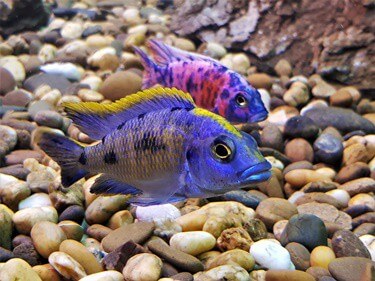
What Cichlids Go Well Together?
Not all cichlids can be mixed, as they’re too aggressive. But many of the peaceful species on our list tolerate other cichlids well.
This includes keyhole cichlids and angelfish. They pair well together because they’re both peaceful fish. While many cichlids are tempted to nip an angelfish’s long fins and tail, keyhole cichlids prefer to leave them be.
Similarly, discus fish get along with dwarf cichlids. Dwarf cichlids are happy to live in warm, soft water, which discus fish need, and adapt to various pH levels. Both fish enjoy a well-stocked tank with plenty of plants and features, so they tend to leave each other alone.
Bolivian rams and German blue cichlids are also suitable tank mates. Bolivian rams do well with all dwarf cichlids, as they’re shy and prefer to be around slightly smaller fish.
How To Prevent Aggression In A Community Tank
While there are plenty of non-aggressive cichlids for community tanks, peacefulness isn’t necessarily guaranteed. If the tank’s conditions aren’t right or there are underlying factors upsetting the fish, they could become intolerant of one another. As a result, follow these steps to prevent cichlid aggression in your tank:
Consider The Fish’s Size
As we’ve already established, cichlids come in all shapes and sizes. Many are small and are bullied by larger fish as a result. To prevent this, choose community fish that are a similar size to your chosen cichlid. Or, if in doubt, select a species slightly larger than the cichlid to minimize the risk of aggression.
Similarly, it’s a wise idea to choose tank mates who like to occupy different areas of the tank.
For example, some cichlids like to remain at the bottom of the tank. Choosing fish with a similar preference is likely to cause friction, but choosing fish that prefer to occupy the middle and top sections of the tank will keep them happy.
Choose Fish With Different Colors
African cichlids view members of their species as competitors. They distinguish fish by colors and patterns, and if they see fish with similar markings, they’ll become territorial towards them.
While South American cichlids don’t seem to mind mixing with other cichlids as much, it’s best to house the African species with cichlids or other fish that look different.
Keep The Tank Clean
Poor water quality causes stress and aggression within the tank. For example, if the water is tainted with harmful ammonia and nitrites, the fish will get sick, displaying aggressive behaviors due to their unsuitable environment.
To prevent this, carry out a water change every other week and scrub the tank’s sides to remove traces of algae buildup.
Provide Enough Territory
Whenever keeping a species of cichlid, you must provide plenty of rocks and accessories at the bottom that they can dig around in. Otherwise, they’ll fight for the limited territory available, even if considered a more peaceful cichlid.
For similar reasons, provide a tank with plenty of surface space. If the cichlids become aggressive, rearrange the tank to reset the territory and reduce territorial aggression.
Minimize Male Fish
Male cichlids are more aggressive than females. They’re also more aggressive during mating season, so to keep the peace within the tank, consider choosing all-female cichlids. Or, stick to a ratio of one male per three of four females.
Having too many males creates a toxic environment within the tank, as they’ll fight each other to mate with the limited number of females available.
Keeping cichlids is a rewarding experience, and while some are suitable for beginners, it’s wise to do your research beforehand to provide the best conditions.
Cichlids can become aggressive due to various factors, so getting the basics right will produce a harmonious community tank.

